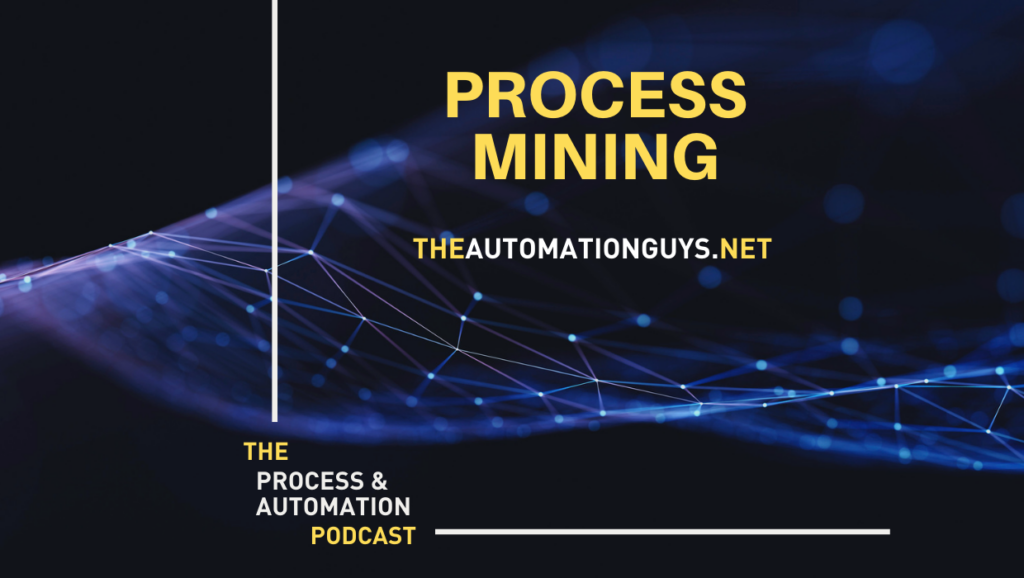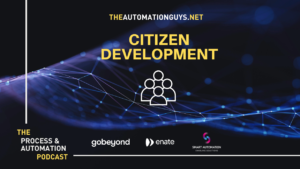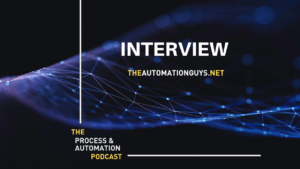Blog

Process Mining Q&A Part 1 - #19
In today’s episode you’ll find answers to the most common questions that we get from companies, mainly asking if they could use process mining to gain insights into their operations and business processes.
Share This Post
Do you have any questions? Would you like to give us feedback? Are you interested in workshops on the topic of automation? Are you an expert in the field of automation and would like to be on the podcast?
LinkedIn Arno: https://bit.ly/3aABArd
LinkedIn Sascha: https://bit.ly/36Jd31T
Velocity-IT: https://www.velocity-it.com/about-us/
convedo Group: https://www.convedo.com/about-us
Episode Transcript
Heard about process mining but you are still unsure about how it works and why you should use it in your organization, then this episode is for you.
Hello, and welcome back to the process and automation podcast with the automation guys. In today’s episode, you will find answers to the most common questions that we get from companies, many asking if they could use process mining, to gain insights into the operations and business processes. We have also asked the audience recently, what I like to know about process mining, and today, we will share the answers with you.
So let’s get started. So we have a couple of questions here. So the first one up is on how does process mining software work on such a process mining software, and you know, there’s various products on the market at the minute, but what it does is it draws event data directly from your back in the information systems such as your DRP systems, your CRM systems, even your BPM systems, and then it presents that automatically as a visualization in a flow chart or dynamic flow chart, which you can then investigate and all of this is dynamic, you can investigate in any part of your running processes, and drill into you know, different areas of your processes, you can you can look at trends, you know, for a high level of your processes, such a really empowers you, you know, to tackle some of these, these kind of bigger processes challenges that we see. So, for example, you can instantly identify inefficiencies and risks in your processes. So these are bottlenecks, for example, lead long lead times compliance violations, for example. And also, you know, you can spot new opportunities with inside your processes. So, for instance, you know, the most suitable and profitable processes, for robotic process automation, for example. So it’s really just something that, that, that, that, that gives you an insight. So there’s a lot in process mining, but I think in a nutshell, it is all about discovering, you know, with inside your existing pre-existing data set, you know, what are the opportunities, you know, where are the optimization that you can exploit within, in with inside your business? So, um, so there’s always this question, you know, who can use process mining? And where do you use it? And essentially, you know, any organization out there can use process mining? And it’s, you know, it’s not limited to a specific industry, it’s across industries as well.
So aren’t the short answer here is, you know, who can use it? Well, anybody can use it, all you need is just to be able to point this to, like I said, Your, your existing erp data set, there is this thing where, you know, larger organizations with, with a lot more complicated processes, do get a lot more out of process mining. And I think that that to a degree is true, because obviously, the larger organization is, you know, the more sort of data you create, and the more insights you can extract. So, so do you process mining vendors, and, you know, they have process analysers that that could look at this, this, this data, and obviously, the larger the data set is, the better, because that will just, you know, give you a lot more insight as to the opportunities that exist with inside your, with inside your, your, your data that could lead you to deploy robotic process automation.
And also, you know, on kind of a wider scale, you know, what’s the direction of your digital transformation initiative? And, of course, you know, for audit and compliancy when you look at your processes, and you know, from an auditing compliance perspective, are you compliant, are compliant with you know, the industry standards? How does your processes look like? So did so these are just evidence that is already with inside your data, but process mining actually unlocks that for you. So it’s quite interesting that you talk about this, look at the kind of the cost.
Common Questions and Answers around process mining. And I think today what we want to touch on is, it’s really sort of this, this trend that we’re following on the frequently asked questions that people tend to ask us, you know, around the topic of process mining.
You know, the first one we’ll look at is, is the, you know, the typical one we tend to get, and, you know, I’ll get your view on this in a second, where people already got a business intelligence system where they can obtain analytics.
You know, and then they ask, Well, you know, what, why, why should we have another system that gives us information in Why should we deploy process mining? We’ve already got Bi?
Yeah, absolutely. Yeah. So I just wanted to before going to this one. So the So you mentioned, today, there are huge benefits, obviously, by applying process mining into an organization. Just last week, I was at a conference. And GE Healthcare, for example, they used to enable, the organization was process mining. And they uncovered 1.3 billion US dollars of sort of inefficiencies in the organization. And this is just incredible, obviously, on a global scale. But without that, they obviously just had to guess where that inefficiency in and they was looked very siloed, this this place here, this place there. Now having this full visibility, then that helps you to get this one sort of one, one system, and to really see where these inefficiencies are. Really. Yeah. So now to the question. So why should we take another system for further analysis, really, of what’s going on in the business and the array, there are clear differences between business intelligence systems, and process mining. So both systems are really, yeah, they have the same purpose, sort of providing insights, what’s going on in your business and in your processes to make better decisions.
Although both bi and process mining help you measure, and monitor targets, process money add to this by helping you quickly perform process analysis in real time. So and, and it drills even a bit deeper, and shows really, really good variations of processes, how they are running in real time, as well. So and, yeah, and it really comes with this pre built templates, and pre build analysis, the analysis is really where you can look very specifically a bottleneck connects for maybe purchase to pay order to cash, these kind of things, compliance violations. So this is where differentiates really from a normal BI tool where you may be used probably more for KPIs and just
the other kind of stuff, but not really, on the whole set of process variance running through your company. Yeah, so I guess with business intelligence, you go in knowing what you’re looking for, because you specified it. Yeah, with process mining, it’s the opposite. You don’t necessarily know what you’re looking for. And you’re on this explorative mission. And then in reuse these things for you, again, in real time. Yeah, yeah, so one is kind of predetermined, these are the sorts of analytics that we need, or we can explore these things. And then there’s a set of have a kind of a framework that we work within.
And it’s known entities and known elements, whereas process mining really takes that to the extreme, where it really unlocks these dark areas of manual processes with inside your business.
So it really helps you as well. So this is the another really significant differences, really finding as well, the root causes of what’s going on. So you’re not just see that something is going on. So you can really drill the real in and find out, okay, just was this customer or just was this region, we have that problem. And you can drill down really to the to the actual order to the actual contract, because everything will process mining does. It collects all these event data is not very specifically order ID timestamp, and what kind of stage sort of is currently and compiling all that stuff together. Yeah, process mining really revealed the problem areas in the process. Bye. Bye. We’re really showing them in this really nice user-friendly flow charts. And you can really see what is the most important one to take.
Yeah. So kind of like the, I guess the, you know, by looking at, you know, your data, it provides these answers, you know, what is happening in the background? When is it happening? But also why is it happening? And that’s the sort of things right.
Yeah. And then I think one more difference between process mining and BI tools.
Yeah, it’s, it’s, it’s, it’s about the ease of use. So you mentioned that earlier, so you define it to all proactively if you have a BI tool, but you’re here, now you have millions of rows, you process you couldn’t really tackle with traditional bi methods. So you now get this really understandable overview. And it’s just really millions and trillions of data was if you think about GE, healthcare globally, so what kind of data volume they must have pulled into that. It’s, it’s incredible. And the data and the data will grow even more, isn’t it? So we will double the data again, and again, again, every year. So I think only tools like your process mining was towards like process mining, you can really make that data he really usable. And that’s, that’s extremely exciting. Yeah, yeah.
So, next one, which was submitted.
Yeah.
So when we find a problem, in the process, how does process mining help us to fix those problems? Yeah, and that’s an excellent question. I think people approach process mining and look at it as
a magic unicorn that just goes out and fix problems. And the reality is, is slightly different, in that it will bring the unicorn out, but you still need to go out and, you know, fix those problems, but at least you know where they are, right. Because if you do have a very large organization with lots of processes, process, mining can actually give you that ranking, where to go and spend your effort at and which area of your business to, to really focus on, you know, for the for these problematic processes. You know, they always say, it’s not to say that you could use, let’s say, word, for instance, you can write brilliant documents, and it’s the same with process mining, you know, it, it can’t fix problems for you, but it has got built in root cause analysis, and it does help you to identify and locate these, you know, most significant, the most significant problems. And because it’s visual, you can see that at a glance, and it can also notify you when things go wrong in the process. So you can then proactively act to optimize these processes within, you know, the business units, where the impact is really large, and you can fix these issues before you before they even happen. You know, rather than waiting a year down the line, and, you know, the somebody’s notifying you to do something’s going wrong, and it cost the business, you know, a lot of money.
And, you know, what, when, when you discover, you know, how these processes work in, in reality, and you can also find other areas that you want to dig in a bit deeper. So I guess it’s sort of fixing a specific thing. And it can either be tactically, but I think process mining gives you the ability to drill deeper into areas of the process where you at least you fix something, it’s better now you can actually refine, you know, that that process a lot more. And, you know, again, with most of these tools, they support root cause analysis, they give you very good metrics on a root cause analysis. So, you know, so you could, again, you can see, what’s causing the biggest problems are such as the long lead times or waste a lot of repetitive, you know, work.
And again, you know, besides sort of identify the areas that’s, that’s, that’s causing problems, like I said earlier, it also ranks them according to their contributions to business outcomes, for example, so you could prioritize these corrective actions that you want to take.
But you know, you still need to fix that problem. And in order to fix that problem, you know, you need to identify it first, and what’s the kind of the root cause of that? And that’s really, that’s really important. So again, you know, this this idea that process mining gives you good root cause analysis.
This is really key to it, because it is really integral to success, you know. So you could use this to, instantly analyse these processes.
You know how the duration of these, these processes, their conformance to compliancy, for example, and this is this is this is really important sort of capabilities that allows you to unlock these problems and get to the root cause of a problem.
You mentioned earlier, so this was process mining and when the when this problem occurs in real time, end users and business owners might be identified, notified about this problem, and they can then immediately take action. I think the next step when we when we’re obviously talking about sort of end-to-end automation. So, so we can pluck our automation in in in real time identification of a problem. So, instead of just being notified about, Hey, there was this kind of issue, we can then take that further and automate that resolution in the in our backend system. So, if we identified a compliance issue here, we can notify people, but at the same time, we might need to go into our ERP into our SAP system to change something maybe.
Unfortunately, that’s it again, was this episode of the process in automation podcast. If you liked this episode, please give us a five-star rating. And don’t forget to subscribe to this podcast, so you don’t miss any upcoming episode. We hope you will tune in next time and until then, let’s automate!
- April 19, 2021
- 8:32 pm


